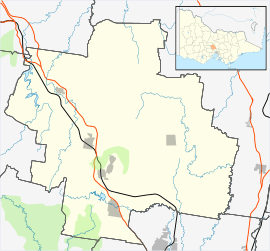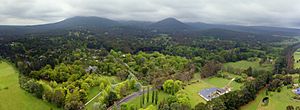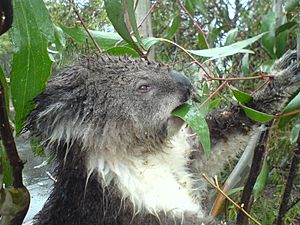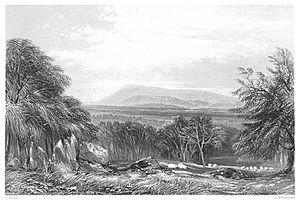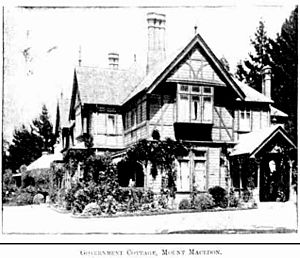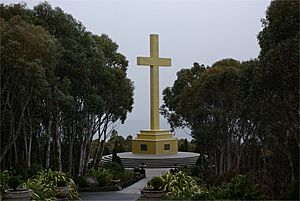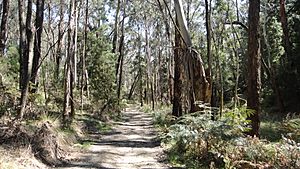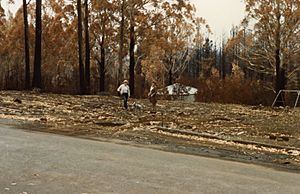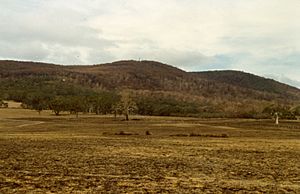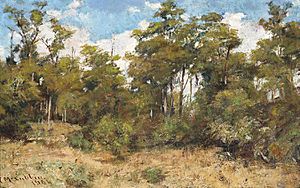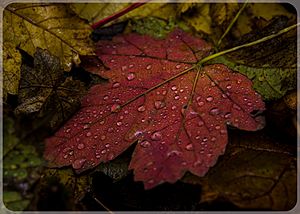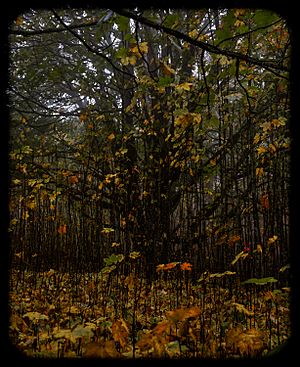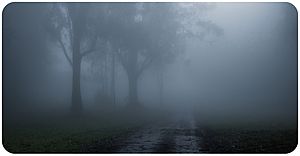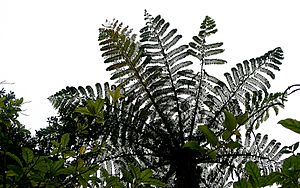Mount Macedon, Victoria facts for kids
Quick facts for kids Mount MacedonVictoria |
|||||||||||||||
|---|---|---|---|---|---|---|---|---|---|---|---|---|---|---|---|
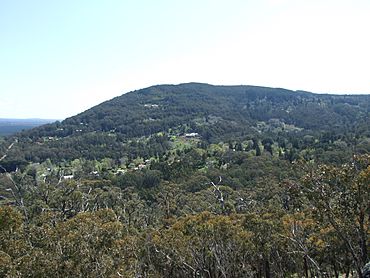
Mount Macedon village from nearby Mount Towrong
|
|||||||||||||||
| Population | 1,335 (2016 census) | ||||||||||||||
| Postcode(s) | 3441 | ||||||||||||||
| Elevation | 615 m (2,018 ft) | ||||||||||||||
| Location |
|
||||||||||||||
| LGA(s) | Shire of Macedon Ranges | ||||||||||||||
| State electorate(s) | Macedon | ||||||||||||||
| Federal Division(s) | McEwen | ||||||||||||||
|
|||||||||||||||
Mount Macedon is a small town located about 64 kilometers (40 miles) north-west of Melbourne in Victoria, Australia. This town sits just below the mountain of the same name, which reaches a height of 1,001 meters (3,284 feet).
In 2016, Mount Macedon had a population of 1,335 people. It is famous for its amazing 19th-century gardens and huge, fancy homes. These gardens are considered some of the most important in Australia.
Contents
Discover Mount Macedon's Unique Features
The town of Mount Macedon was mostly built by rich people from Melbourne in the mid-to-late 1800s. They used it as a cool place to escape the summer heat. The local post office first opened on July 18, 1870.
Because Mount Macedon is about 620 meters (2,034 feet) high, it has much cooler weather than nearby Melbourne. The area also gets a lot of rain. These natural features have made the town a popular holiday spot and a place where wine is made.
Snow often falls on the higher parts of the mountain. Sometimes, even the lower areas of the town get snow, and it can be quite a lot!
The gardens and homes in Mount Macedon are well-known for their large size and beauty. Some even have rare and unusual plants from other parts of the world.
The Majestic Mount Macedon Mountain
The mountain is known as Geboor or Geburrh by the Wurundjeri people, who are the traditional Aboriginal owners of this land.
The Mount Macedon area also has another important peak called the Camel's Hump. This peak rises to 1,011 meters (3,317 feet) above sea level. Its volcanic rock is popular with rock climbers, making it a great spot for sport climbing near Melbourne.
Mount Macedon's Rich History
The mountain was first seen by explorers Hamilton Hume and William Hovell in 1824. They were on an expedition from New South Wales to Port Phillip and named it Mount Wentworth.
Later, in 1836, explorer Major Thomas Mitchell climbed the mountain. He renamed it Mount Macedon after Philip II of Macedon. He chose this name because he could see Port Phillip from the top. Other places he named in the area, like the Campaspe River and Mount Alexander, were also named after figures from Ancient Macedonia.
Historic Places in Mount Macedon
Government House
In the late 1880s, the state government bought a large property called 'Rosenheim' to be the summer home for the Governor of Victoria. It was a big, two-story wooden house with 31 rooms, plus separate rooms for servants, a lodge, and stables.
By the 1930s, this home was known as Government Cottage. In 1934, it was sold to help the government save money during tough economic times.
Barbours Tramway and Log Chute
The Barbours Tramway and Log Chute is a very old site located on the northern side of Mount Macedon. It was built around 1856 to help move logs from the top of the mountain down to a sawmill.
This site is important because it's the oldest known log chute in Victoria and one of the oldest parts of a tramway still existing in the state.
Macedon Sanatorium for Consumptives
Mount Macedon was once home to the Macedon Sanatorium for Consumptives. This hospital treated patients with Tuberculosis (a lung disease) in the early 1900s. It opened in 1898, chosen for its high location and climate, which was thought to help lung conditions.
Annis and George Bills Horse Trough
On Mount Macedon Road, you can find an Annis & George Bills Horse Trough. These troughs were set up by a special trust created by George Bills, who wanted to make sure "no animals to go thirsty." He donated about 500 of these horse troughs to towns across New South Wales and Victoria.
Fun Attractions in Mount Macedon
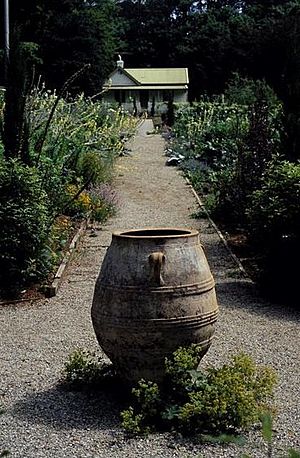
The Memorial Cross
One of the main attractions in Mount Macedon is the 21-meter (69-foot) high memorial cross. It stands near the mountain's summit. This cross was built in 1935 by William Cameron to remember those who died in World War I. From the top of Mount Macedon, you can see Melbourne city, the Dandenong Ranges, and the You Yangs near Geelong.
Exploring Mount Macedon's Forests
Another great part of the Mount Macedon area is its large native forests that cover the mountain and surround the town.
In the early 1800s, many trees were cut down for building and for the gold mining industry. This caused a lot of deforestation. So, in the late 1880s, people started efforts to replant the forests.
Much of the forest on Mount Macedon has wet sclerophyll plants, which are usually found east of Melbourne. You can find Alpine Ash and Mountain Ash trees here, even though this is the western edge of where they usually grow. Snow Gums are also found on the highest peaks. A large part of the Macedon Ranges forest is now protected in the Macedon Regional Park, managed by Parks Victoria.
The area was badly damaged by the 1983 Ash Wednesday fires. However, the forests and gardens have since grown back.
Famous Houses in Mount Macedon
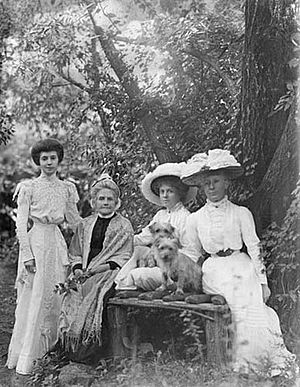
Mount Macedon is home to many grand and historic houses:
- Alton – This Venetian Gothic house was built in the 1870s. Its beautiful gardens cover 4 hectares (10 acres) of the property. The house was rebuilt after a bushfire in 1876.
- Braemar House – Built in 1889-90 as a fancy hotel, this large timber mansion now houses Braemar College. It was once home to Clyde Girls' Grammar School, a boarding school famous for being featured in the novel Picnic at Hanging Rock.
- Campaspe Country House – This former notable house was turned into a fancy hotel in 1927. It sits on 13 hectares (32 acres) of landscaped gardens.
- Derriweit Heights – Built around 1874, this home was one of the first near the peak of Mount Macedon. It was designed to have amazing views and a world-class garden. The original home was mostly destroyed in the 1983 Ash Wednesday fires but has been rebuilt.
- Drusilla – This impressive red brick house was built for the Grimwade family. From 1948 to 1976, it was a training center for the Marist Brothers.
- Duneira Estate – The land for this historic estate was bought in the early 1870s. It includes stables built in 1874 and a main residence from 1875-76.
- Fontainebleau – This house was moved to Mount Macedon and bought in 1901 by the artist Frederick McCubbin. He named it after the forests near Paris.
- Karori – Built in 1888, this property was the summer getaway for Charles William Chapman, a businessman from New Zealand. He brought many materials and trees from New Zealand for the house and garden.
- Marnanie – This historic home was once owned by Sir Isaac Isaacs, who was the first Australian-born Governor-General.
- Penola – This grand 19th-century garden estate covers 4.5 hectares (11.2 acres). Its large house was actually built in Singapore and then moved to Australia!
- Sefton – A large and grand house built by the Baillieu family as a summer holiday home in the early 1900s. Its 8.8-hectare (22-acre) English garden was designed by famous botanists.
- Shepherd's Bush – This grand Victorian summer home was destroyed in the 1983 fires, but its beautiful 1.2-hectare (3-acre) garden, known for its spring and autumn colors, still thrives today.
- Timsbury – Built in 1875, this house is a great example of the "gingerbread" style, with carved wooden details and decorative verandahs.
Beautiful Private Gardens
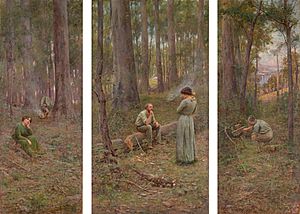
Mount Macedon is famous for its many private gardens, some of which are open to the public:
- Alton – This garden was a filming location for the 2006 Australian movie Macbeth. It has a large Venetian-Gothic house and a botanical garden.
- Ard Rudah – This 140-year-old garden is recognized by the National Trust for its historical importance.
- Bolobek House & Garden – This is one of Australia's most amazing gardens and is often open for visitors.
- Cameron Lodge Garden
- Dreamthorpe Garden – The owners say this garden shows the influence of famous English garden designers.
- Duneira Estate – This historic estate is regularly open to the public.
- Forest Glade Gardens – These gardens are over 100 years old and are open every day during the season.
- Glen Rannoch Garden – This garden is listed on the Victorian Heritage Register and has been featured on the ABC TV show Gardening Australia.
- Gresford
- Hascombe – This huge 28-acre garden is owned by Linfox and has an annual open day for charity. It has one of only two Himalayan Fir trees in Australia.
- Huntly Burn – Also listed on the Victorian Heritage Register, this garden is considered one of Victoria's top historic gardens.
- Karori – This garden dates back to 1888 and was a summer retreat.
- Lewisham – A modern garden.
- Marnanie – This garden was once home to Sir Isaac Isaacs, Australia's first Australian-born Governor-General.
- Penola – A garden estate established by the sister of William Guilfoyle, who created the Melbourne Botanic Gardens.
- Sefton – This English garden was designed by famous botanists and built by the Baillieu family.
- Shepherd's Bush – A 140-year-old garden known for its beautiful spring and autumn colors, with many rare European and North American plants.
- Tieve Tara
Mount Macedon in Movies
Mount Macedon has been used as a filming location by some US film companies. This is because it's cheaper to film outside the US, and the buildings and gardens here look a lot like places in the Northern Hemisphere with many trees that change color in autumn.
The 2009 Nicolas Cage movie Knowing was filmed in Mount Macedon and nearby Macedon. The movie Don't Be Afraid of the Dark was also filmed here in 2009. Scenes from Where the Wild Things Are were filmed in the forests around Mount Macedon.
Sports and Activities
Golfers can play at the Mount Macedon Golf Club. In the 1930s, an annual tennis tournament was held in Mount Macedon. In the past, fox hunting was popular in the surrounding forests.


